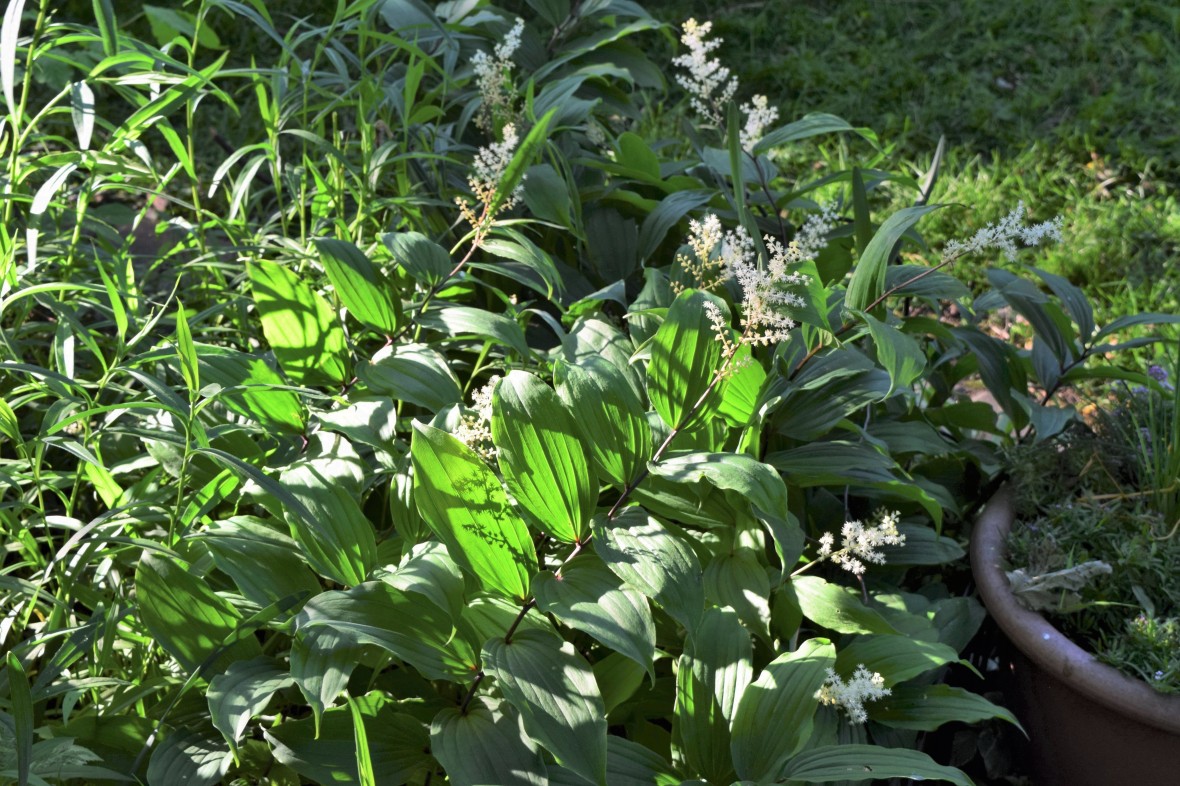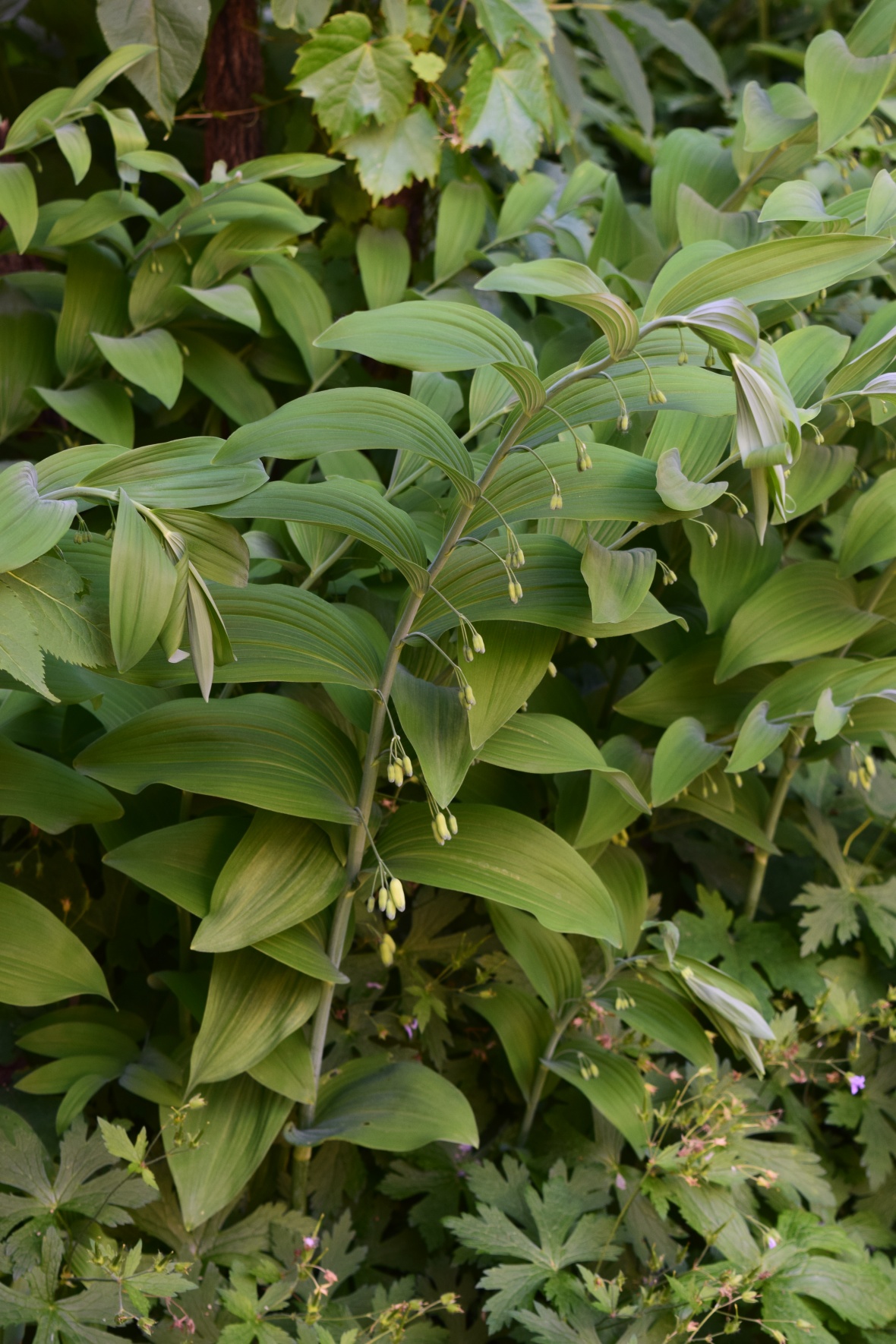Solomon’s Plume, an Underused Woodland Native
Solomon’s Plume (Maianthemum racemosum) has a lot in common with Solomon’s Seal (Polygonatum biflorum). In fact, Solomon’s Plume more often went by the common name False Solomon’s Seal. Canny native plant sellers saw correctly that this undermined the woodlander’s appeal, and so they promoted an alternative. Either way, my point is that you are much less likely to find Solomon’s Plume in home gardens than Solomon’s Seal.

Both are woodland plants grown mostly for their foliage. In May, Solomon’s Plume has feathery flower clusters growing at the end of its 2-3′ arching stems. The flowers give way to red berries in the fall. Solomon’s Seal has flowers dangling all along the stem, followed by berries that turn black when ripe.

In my experience, Solomon’s Plume spreads slowly, while Solomon’s Seal can be highly aggressive. I have a modest patch of Solomon’s Plume in the back garden located at the foot of a Silver Maple, and a rapidly growing patch of Solomon’s Seal growing on the east side of the house.

Once the berries are ripe, I do have trouble keeping the stems of Solomon’s Plume from flopping. I’ve employed a variety of strategies with mixed success. Solomon’s Seal, though taller, seems more reliably upright.
The flowers of Solomon’s Plume attract small bees and beetles, both of whom serve as pollinators. The berries, though toxic to people, are eaten by woodland birds.
Have you ever tried growing Solomon’s Plume?





I haven’t grown either, but great shots and comparison.
Thanks!
I just snagged a piece of Solomon’s Seal at our annual garden club flower sale. I didn’t realize it could be aggressive. I will have to try to keep it under control. Thanks for the warning! 🙂
People seem to have varying experiences with it depending on conditions.
I love Solomon’s Plume. It has been growing in my bed of Lillies of the Valley and is slowly gaining ground. Very elegant.
That’s a good description.
Looks like a terrific plant and it grows in the shade, which is a plus. Alas, it won’t grow in my zone 8 or I’d buy it.
Nice, but Solomon’s Seal is so elegant, especially in a vase!
Hmm, never thought of it in a vase.
Solomon’s plume flowers look cute and tender ❤
The flowers are beautiful, they would look lovely in the woodland here, I must try and find one.
I have lots and lots of Solomon’s Seal because it is quite aggressive as mentioned. If Solomon’s Plume is less aggressive, I need to get some.
Another question: Do you grow any perennials that do not die back to the ground? I would love to know what they are. I don’t like to have a lot of bare ground in winter. Thanks.
A perennial that comes immediately to mind is Hellebores. They are evergreen.
Thanks, Loretta. I actually have several hellebores plants. I love them and am adding a few each year. Do you grow the H. foetidus? I have LOTS of them because they volunteer like crazy. This past year I had more new plants than I knew what to do with. I have transplanted many of them in different beds. It covers the ground fast and is attractive, but I do like the nursery-type hellebores better with more variety in the flower colors.
The ground here is frozen or covered in snow during the winter. I don’t know if I have anything that is truly green through the whole year. Hellebores are the closest to that, I think.
I do not have Solomon’s Plume but do have a lot of Solomon’s Seal. They have spread more than I like, but then I’m able to share them at our annual plant sale. 🙂
I have seen Solomon’s Seal in the local nursery, but have never purchased it. I am trying not to buy anything this year (well, OK, one new crabapple, a couple peonies and a butterfly bush, but I am done!!!) after a neighbor said I had a plant addiction.
Words of wisdom I once read on the internet:
“If someone tells you you have too many plants, stop talking to them. You don’t need that kind of negativity in your life.”
🙂 OK. If this neighbor is a good person and you don’t want to stop talking to her/him altogether, just ignore their garden ideas. It’s your garden.
Oh, what do neighbors know?
No Soloman’s Seal here. I have both of the Soloman’s Seal. The variegated SS grows FAST. I plant that where ever I have trouble getting anything to grow and it grows. The regular SS isn’t so fast. I would think anything planted under a Silver Maple would grow slow as the Silver Maple would suck up all the water and nutrients available.
That could be why the Solomon’s Plume spreads slowly. I always thought variegated plants were less aggressive than their non-variegated cousins, but I get not.
I didn’t know about Solomon’s Plume. It is very pretty.
(Sorry to have missed weeks of your blog — was touring gardens in England!)
Pretty good excuse!! Sounds wonderful!!
The leaves are lovely – I would be hard pressed to tell one from the other if they were not in bloom. Solomon’s Seal grows where I volunteer and I was going to get a bit from them, but now I’ve decided otherwise. With our mild winters in the past couple of years, I’m already having issues with other, previously well behaved spreaders taking over large areas of the garden. How do you keep yours in check? or do you?
I am not keeping it in check….I hope it crowds out the Lilies of the Valley.
Mostly I just let the spreaders battle it out. Sometimes I take a shovel and dig up a few clumps of rhizomes.
Lovely! Just planted Solomon’s Seal this year. We’ll see how it spreads. Solomon’s plume is lovely, too.
I’ve never heard anyone call this plant Solomon’s Plume, everyone around here still calls it False Solomon’s Seal. It’s fairly common in gardens and nurseries here, I’ve seen large clumps of it, and it isn’t a timid grower. I think it particularly likes our PNW climate. I have both now, I just planted the False Solomon’s Seal last fall. My Real Solomon’s Seal is the variegated one, and hasn’t been that aggressive either. Eight years in the ground and still not much larger than a one square foot patch.
WOW! I can hardly believe your Solomon’s Seal has not spread further in eight years. I’ve had mine for probably ten years. It’s also the variegated one. Mine spreads so quickly that I have dug it up several times to plant in three other parts of my property. This spring, I decided I needed to pull some of it out and give it away. I have no more places to put it. My garden is in Richmond, VA. Like they say, a plant’s behavior has a lot to do with the garden site.
Very true.
Interesting that Solomon’s Plume is common there – don’t think it’s native to the PNW. Another common name, apparently, is “Feathery False Lily of the Valley” – a real mouthful!
I just planted some on the north side of the house last year, and a couple more this year. They are quite floppy. I have Solomon’s seal in a wash tub, and a clump of the variegated kind across the street where I also garden, and it has not spread aggressively.
I don’t have to grow it, it’s everywhere here. I was just looking at some today, in fact.
I’ve never seen it in the forest preserves here, but I don’t spend as much time as you in the woods.
Solomon’s Plume grows wild all along the roadway to our house. S.Seal has not been overly aggressive in the woodland garden here.
Must be a lovely drive!
Yes, we have both Solomon’s Seal and Solomon’s Plume growing naturally in the woods in the back. I like them both. I need to move a few of the Polygonatums out of the cultivated beds and back into the woods. As you say, Solomon’s Seal is a little more aggressive than Solomon’s Plume, but easily moved and managed.
You’re lucky to have them both growing naturally nearby.
I didn’t know it even existed. Thanks for the info
It is lovely. It doesn’t spread very fast here, in fact I must go and see if it is still there.
Hope it hasn’t disappeared on you!
I’ve grown both seal and plume and love them. My patch of Solomon’s Seal grows in the fairly dense dry shade of a large Japanese maple and, perhaps because of that, it’s not proven aggressive at all. I keep trying with Maianthemum and hope to someday have a nice patch of it.
A good way to control an aggressive plant is to put it in a challenging spot, as you have done.
I have not grown the false Solomons’s Seal, but I have grown the variegated one. It does spread for me, but happily, not overly aggressive. At least not yet, after about three years. There is still time for it to reveal its true character! I have planted it where it may spread as far as it wants, except in one direction, where it would meet my woodland path. As I said, no problems yet!
I grow Solomon’s Seal in deep shade where it is especially useful but have never grown Solomon’s Plume, I would be interested to know if it is attacked by the Solomon’s seal sawfly larvae because if it isn’t it would make a good alternative as the sawfly can completely defoliate the Solomon’s Seal.
I haven’t seen the sawfly on either in my garden, thank goodness. I hope it stays that way!
I have some Solomon’s Seal but I’ve never seen ‘plume’ grown here.
Might be a bit too dry for your area.
I’m sure you’re right
I’ve never grown either, I especially like Solomon’s plume, such lovely flowers.xxx
Yes, aren’t they?
Hello, I believe what you are describing here is what I have scattered in my woodland. I have succesfully move some into a garden area 8 years ago. I would like to fcreate a larger area on the edge of the lawn, where the woods begin. How would you recommend starting a new bed. Should I collect berries and bury them in the leaf mulch/soil? Should I transplant roots and all in the spring or fall? I would be very selective in moving plants to ensure a good mixture of a natural like setting. Currently, these plants are mostly mixed in with ferns, but I wish to enhance a 40 square foot area with more Solomon’s. Appreciate your thoughts on increasing the population.
Hi Ron. The quickest way to get things going would be to transplant some roots and crowns in the fall. Seeds will also work but will take much longer. You can order plants from some online nurseries like Prairienursery.com and Prairiemoon.com. Good luck!
Thank you … I think I’ll try the autumn root approach. I already laid a layer of well composted LEAF MULCH from our town. It is quite black, and people tell me it’s good stuff. I imagine I’ll have to lay the roots deeper than the mulch, and into the actual soil. If you agree, would 1-2″ under the existing soil be appropriate? Shade gardening is new to me. Thanks again.
My biggest bed seeded itself….maybe birds? I have some in a spot at least 75 feet away where the birds may have gotten seeds. I would try planting the seeds, as you mentioned. Hope it works for you. I love this plant.